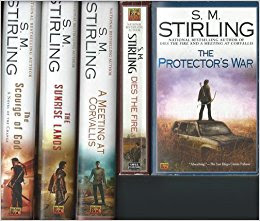I have been in Birmingham for three nights without my laptop. When I try to sign in from a strange PC, Google sends a verification code to my old mobile number so we do not communicate. Any attempt to give them my new number fails. I have much to catch up on so please bear with me.
Poul Anderson and JRR Tolkien based fantasies on Norse mythology but Anderson also wrote in several other genres, mainly hard sf. Birmingham parks have been renamed the Shire Country Park after the Shire in Tolkien's Middle Earth. (Also, a town in Sicily has renamed itself after a fictional one. See
here.)
Dwellers In Space
(i) Olaf Stapledon's pre-galactic nebulae.
(ii) Fred Hoyle's intelligent gas clouds.
(iii) CS Lewis'
eldila.
(iv) James Blish's Angels.
(v) Poul Anderson's
Aurigeans.
(vi) Larry Niven's Outsiders.
(i) and (ii) are gas.
(iii) are "hypersomatic."
(iv) and (v) are energy.
(vi) are solid.
Often, Anderson alone covers every option but sometimes, as here, he does it in cahoots with his illustrious colleagues. What authors' names to conjure with!
In Anderson's First Dominic Flandry Novel And Blish's Second Jack Loftus Novel
(i) Flandry visits Merseia while the Rhoidhunate plots to disarm Terra.
Jack visits Malis just as the Hegemony decides to annex Earth.
(ii) Flandry and his superior meet the Protector of the Roidhun's Council.
Jack and his superior meet the Hegemon of Malis.
(iii) Abrams and Flandry spy on Merseia.
An Angel concealed in the Earth ship spies on the Hegemony.
(iv) Merseians are less rule-bound than human beings.
Malans, even the Hegemon, are entirely ruled by their machine-interpreted laws.
(v) Flandry and one companion flee through hyperspace.
Jack and his two companions flee on the Haertel overdrive.
(vi) Land- and sea-dwelling Starkadians are natural enemies like men and wolves.
Land- and sea-dwelling Terrestrials (men and dolphins) decide to live in amity with each other and thus become able to live in amity with extraterrestrials.
(vii) Blish, like Anderson in other works, discusses the issue of freedom in future high-energy civilizations.
Dig it. Anderson fans, read Blish!
Jack Loftus heard not, as I had thought,
the music of the spheres but a "dismal universal hiss," not quite the same thing! This will lead to reflections on:
chaos in Milton, Heinlein, Anderson and Alan Moore;
Milton as quoted by Lewis, Pullman and Blish.
Laters.

















































